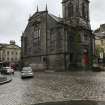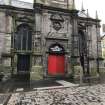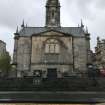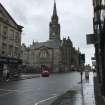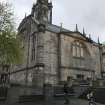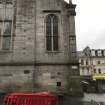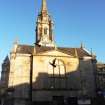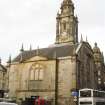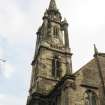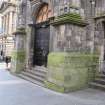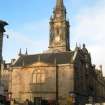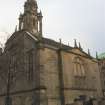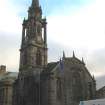Ordnance Survey licence number AC0000807262. All rights reserved. © Copyright and database right 2024.
Useful Links
- Canmore:
- EDINBURGH, HIGH STREET, TRON CHURCH
- Historic Scotland:
- HS Reference No 27552
- World Heritage Site:
- Old and New Towns of Edinburgh
General Details and Location
Category
AT RISK
Name of Building
The Tron Kirk (Former)
Other Name(s)
The Tron Church (Former)
Address
122, High Street, Edinburgh
Locality
Postcode
Planning Authority
Divisional Area
Reference No
2504
Listing Category
A
OS Grid Ref
NT 2592 7363
Location Type
Urban
HS Reference No
27552
Description
Highly distinctive Dutch-influenced Classical-Gothic survival style square-plan church with octagonal steeple surmounting landmark clock tower. Pale ashlar with ornate moulded dressings and obelisk finials. Re-worked extensively over a 200 year period, this Gothic/Classical hybrid ecclesiastical building remains a nationally significant example of its type.
The kirk was founded by King Charles I to house the congregation displaced from nearby St Giles when he made that church a cathedral. Constructed between 1636 and 1647 to a T-plan design by John Mylne, Royal master mason and one of the last masters of the Scots-Mannerist style. The design mixed Palladian and Gothic elements, with a number of details with a contemporary Dutch influence. Master Wright, John Scott, who designed the internal hammerbeam roof was also responsible for the cinquefoil example at Parliament Hall (see separate listing).
The full Chamberlain's Accounts for this project are still extant. The building was truncated in 1785 to rectangular-plan form, involving the removal of one windowed bay from E and W, and the S aisle reduced to a slight pediment projection with detail carefully matched to the original. This work took place to accommodate the construction of Hunter Square and the South Bridge. The kirk´s wooden spire, added by Thomas Sandilands on 1671, burned down in 1824 and was replaced in stone in 1828.
In 1952 the building closed as a church and was acquired by Edinburgh Council, the congregation moving to a new church in Mordun. It was unoccupied for many years, during which time Robert Rowan Anderson's gallery and pulpit interior of 1888 was removed. The steeple was restored by Andrew Renton, 1974-6.
Internal excavations took place in 1974, revealing foundations of 16th century buildings in Marlins Wynd. The Kirk gets its name from the salt-tron, a public weighing beam once located outside the church. (Historic Environment Scotland)
The kirk was founded by King Charles I to house the congregation displaced from nearby St Giles when he made that church a cathedral. Constructed between 1636 and 1647 to a T-plan design by John Mylne, Royal master mason and one of the last masters of the Scots-Mannerist style. The design mixed Palladian and Gothic elements, with a number of details with a contemporary Dutch influence. Master Wright, John Scott, who designed the internal hammerbeam roof was also responsible for the cinquefoil example at Parliament Hall (see separate listing).
The full Chamberlain's Accounts for this project are still extant. The building was truncated in 1785 to rectangular-plan form, involving the removal of one windowed bay from E and W, and the S aisle reduced to a slight pediment projection with detail carefully matched to the original. This work took place to accommodate the construction of Hunter Square and the South Bridge. The kirk´s wooden spire, added by Thomas Sandilands on 1671, burned down in 1824 and was replaced in stone in 1828.
In 1952 the building closed as a church and was acquired by Edinburgh Council, the congregation moving to a new church in Mordun. It was unoccupied for many years, during which time Robert Rowan Anderson's gallery and pulpit interior of 1888 was removed. The steeple was restored by Andrew Renton, 1974-6.
Internal excavations took place in 1974, revealing foundations of 16th century buildings in Marlins Wynd. The Kirk gets its name from the salt-tron, a public weighing beam once located outside the church. (Historic Environment Scotland)
Building Dates
1637-1647; later alterations
Architects
John Mylne
Category of Risk and Development History
Condition
Fair
Category of Risk
Moderate
Exemptions to State of Risk
Field Visits
May 2003, 11/12/2008, 23/11/2011, 17/2/2015, 04/05/2021
Development History
December 2003: Local planners report that the church has been in use as a visitor centre and has now been transferred to EDI, Edinburgh City Council's development body. EDI is now seeking a more long-term use. The church closed for worship in 1952. 11 March 2004: The Edinburgh Herald and Post reports on plans to convert the church into a café/restaurant and performance space. Historic Marlin's Wynd, which runs through the church, could be built over of else incorporated into the plans. The church is currently leased to Black Hart Entertainment, which operates city ghost tours. 30 December 2004: The Edinburgh Evening News reports on £1 million plans to convert the church into a performance and conference venue.
July 2008: Scotsman reports that city council leaders have ordered a new feasibility study for the Kirk as finance is no longer available for the planned refurbishment. The article goes on to report that the council‘s preferred option would be to carry out a joint venture with a developer.
October 2008: Edinburgh Evening News reports that refurbishment plans are being scaled back due to cost. Further funding sources are noted as being pursued.
December 2008: External inspection finds the church is generally in good condition, but with deterioration evident to the windows and some damage to the lower stones by the High Street entrance. The building is currently vacant awaiting the implementation of refurbishment and reuse.
October 2009: The Edinburgh Evening News reports that costs have risen significantly for works to the Tron church and the project is being shelved until next year. The Edinburgh Herald and Post repeats the story.
May 2010: Edinburgh Evening News reports Edinburgh Council and Edinburgh World Heritage Trust, have commissioned Simpson and Brown architects to draw up a conservation statement on the Tron. The study will inform any furture adaptions of the building as part of a search for a partner developer for the building.
March 2011: Edinburgh Evening News reports Edinburgh World Heritage is in discussions with Edinburgh City Council on a future use for the former church. EWH is reported to have proposed using the building to celebrate the Old Town & New Town World Heritage Sites, along with the four other WHS in Scotland. A business plan, potentially including a cafe/ restaurant attached to the rear of the building, is being drawn up.
November 2011: External inspection finds no significant change from the previous site visit. Vegetation growths at roof level have increased in number and size. There is evidence of casual vandalism.
17 October 2012: The Scotsman reports on a masterplan to renew some of the Edinburgh's museums and galleries and bring some unused buildings back into use as cultural spaces. The article goes on to note plans include the conversion of Tron Kirk into a heritage and culture centre is part of this initiative.
26 November 2013: Permission for change of use of the building for a temporary use over Christmas/ New Year events 2013/14 and Jazz and Edinburgh Festival events 2014/15 is being sought, in line with temporary lease arrangements ref: 13/04750/FUL.
17 February 2015: External inspection finds the building in occasional use and that doors have been re-painted. Otherwise, the building remains in much the same condition as seen previously.
25 February 2015: Local planners note the property has been temporarily leased to a Victorian market. Edinburgh World Heritage Trust is undertaking an options appraisal for the long term restoration of the property into a heritage and cultural centre.
25 February 2019: Local planners note Edinburgh World Heritage Trust has created an office space within the building, and are now housed in the former kirk. The Trust is exploring options for a long-term re-use of the building.
4 May 2021: External inspection finds site continues to slowly deteriorate. Plant growth evident in parapets and green staining and damp evident in stonework. Rainwater goods possibly blocked encouraging plant growth. Windows mostly in good order but a couple of small lead lights missing. Doors are securely locked.
14 March 2023: A member of the public informs us that Scottish Historic Buildings Trust have taken out an initial 5 year lease of the Tron (as of 01/05/2022) to allow a feasibility study and development of a capital project to take place to establish a long term use.
As a meanwhile use a Scottish Arts and Crafts Market run by the Scottish Design Exchange runs daily from the site. SHBT have done some repair works, with the longer term goal of undertaking an external repair project or a full capital project.
As a meanwhile use a Scottish Arts and Crafts Market run by the Scottish Design Exchange runs daily from the site. SHBT have done some repair works, with the longer term goal of undertaking an external repair project or a full capital project.
Guides to Development
Conservation Area
Old Town
Planning Authority Contact
PAC Telephone Number
0131 529 3901
Availability
Current Availability
Not Available
Appointed Agents
Price
Occupancy
Part
Occupancy Type
Tenant(s)
Present/Former Uses
BARR original text : Church/Convent/Monastery to Museum/Gallery
Name of Owners
Edinburgh City Council
Type of Ownership
Local Authority
Information Services
Additional Contacts/Information Source
Bibliography
Online Resources
Classification
Churches and Chapels
Original Entry Date
01-MAY-03
Date of Last Edit
25/05/2021



